11+ Natural Remedies for Bug Bites
Covered in itchy insect bites? This article is filled with all natural remedies and things to make for bug bite relief!
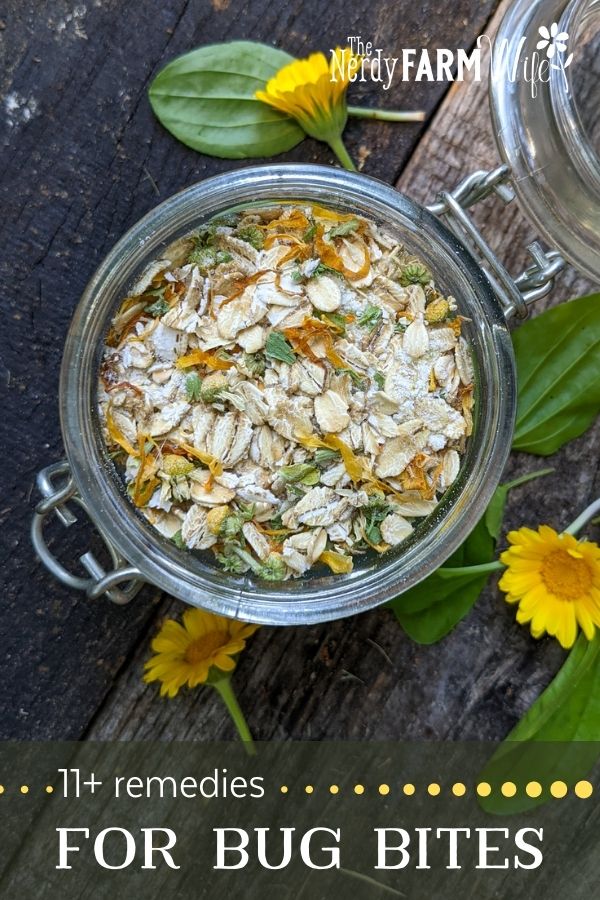
It’s summer time which means lots of outdoor fun in the sun, but also – pesky bug bites!
I’ve tried all sorts of natural ways to get bug bites to stop itching over the years, and these are my top favorites.
Some links on this site are affiliate links; I only recommend products I personally use and enjoy. As an Amazon Associate, I earn from qualifying purchases.

1. “Bug Bite Powder”
Years ago, I used to buy a small jar of white powder from the health food store that seemed to magically help itchy skin conditions – my kids called it “Bug Bite Powder”.
It was expensive and sometimes hard to afford, so imagine my mixed delight and chagrin when I discovered it was nothing more than fancy marketing + white kaolin clay, which I could buy in bulk!
Buy yourself a pound or two of white kaolin clay, usually for under 20 bucks on Amazon, and you have the makings for several years worth of a fine bug bite treatment. (Bonus: You can use it as a spot treatment for acne + other beauty uses too.)
How to use clay for bug bite relief:
There are two ways to apply Bug Bite Powder, aka white kaolin clay.
1. Plain Clay
You can apply the powder directly to the offending itchy spot. I have a relative that uses this method with great success for itchy mosquito bites, and we’ve had good luck with it in the past too.
2. Clay + Liquid
As a second option, you can mix a pinch of the clay with a liquid such as calendula tea (how to make that is in #3 below) or witch hazel to make a paste that you apply directly on the bug bite and let air dry.
I’ve also used this method with teasel or astragalus tincture (or andrographis, per Stephen Buhner, author of Healing Lyme) – as the liquid, to apply to tick bites.
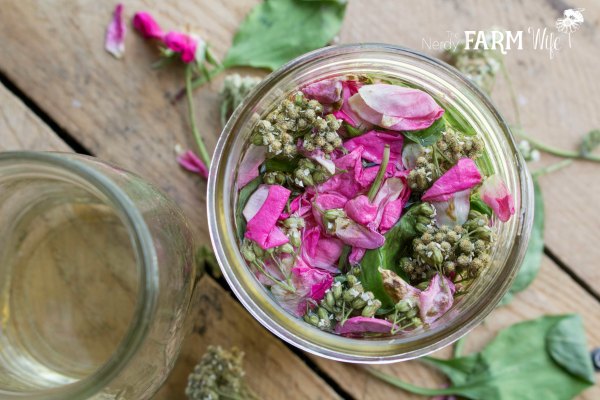
2. Vinegar + Flowers & Herbs
Chigger bites are the worst, but we’ve found that infused vinegars are particularly helpful against them.
You can go simple, and infuse vinegar with just rose petals (they’re anti-inflammatory, and cools red/hot conditions) – directions to do that are in:
Rose Petal Vinegar + 7 Ways to Use It
Or for a more complex (and more powerful) version, try:
Rose, Plantain & Yarrow Itch Remedy
Plantain is tops at soothing irritated skin, and yarrow fights inflammation and itching, plus both herbs can help heal if you’ve scratched too much and made the beginnings of a sore.
To use vinegar to relieve chigger bites:
Generously apply infused vinegar to the itchy area using a cotton ball. Apply heavily and air dry. You will probably need to repeat the treatment several times over several hours. If possible, apply whenever you start feeling itching again.
To use vinegar for wasp stings:
Dab on wasp stings with a cotton swap or cotton ball and allow to air dry. Apply as often as needed.
Does it matter what kind of vinegar you use for bug bites?
No, you can use apple cider vinegar or regular white vinegar.
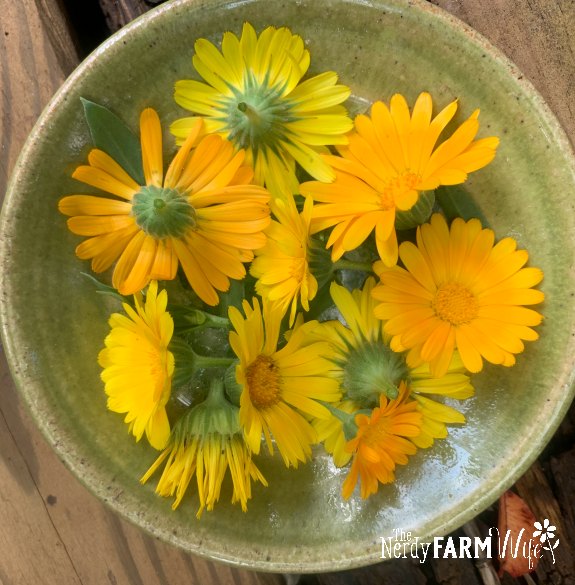
3. Calendula Tea
Calendula tea is like the Swiss Army Knife of my natural first aid toolbox. If someone has sunburn, diaper rash, irritated eyes, sores, rashes, itchy scalp, or bug bites – calendula tea is the first thing I reach for.
Calendula (Calendula officinalis) is anti-inflammatory, antibacterial, and has skin healing properties. (Related article: Calendula vs. Marigolds – The Differences)
Calendula tea is easy to make:
Fill a heatproof jar about 1/4 to 1/2 of the way with dried calendula flowers or petals, then pour simmering hot water to almost fill the jar. You could also throw in some plantain (Plantago major) leaves, for more healing goodness. Steep until it cools, or even overnight in the fridge if you need a really strong tea for external use. Strain through a coffee filter and store in the fridge for a day or two. Freeze for longer storage (see Frozen “Herb Juice” Cubes below.)
To use calendula tea for relief from itchy insect bites:
Apply the cooled tea directly to the itchy spots. You can also put the tea in a spray bottle to store in the fridge – spritz on your skin as needed for cooling and healing relief! Let the tea air dry on your skin. You can also add a couple of cups of calendula tea to your bath water to soak in.
Check out my article, 14 Uses for Calendula Tea, for more ideas.
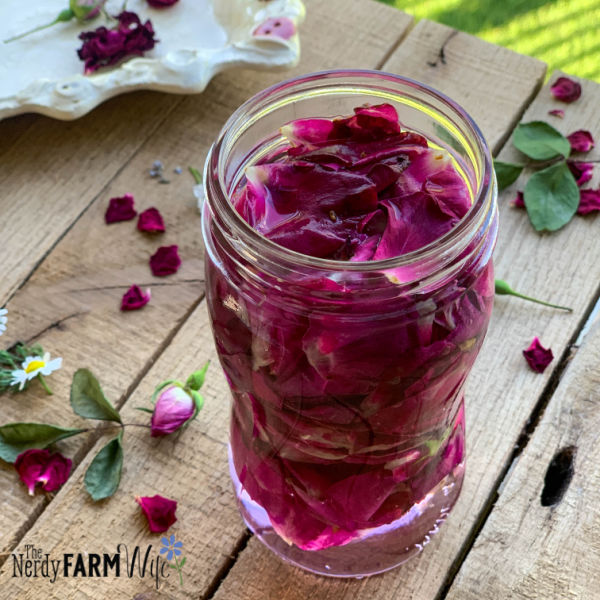
4. Witch Hazel
Witch hazel is a classic cooling and anti-inflammatory product that helps soothe everything from sunburn to hemorrhoids. It’s nice for bug bites too!
You can use it directly on bug bites, right out of the bottle, or you can first infuse it, as demonstrated in:
The Rose, Plantain & Yarrow Itch Remedy, already mentioned above, is made up of part vinegar, part witch hazel, so you can mix as match those two ingredients as well – just be sure to label well so no one accidentally ingests witch hazel!
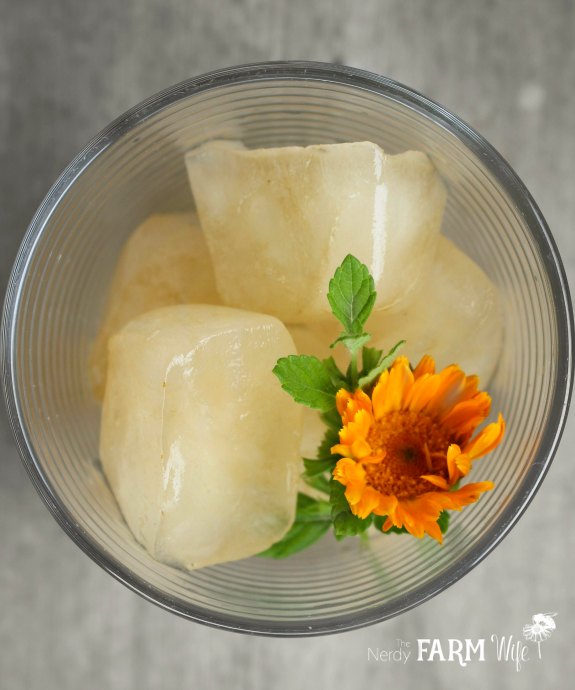
5. Frozen “Herb Juice” Cubes
There are two ways to make frozen herbal cubes.
Method 1: Use Dried Herbs
This is good for dried herbs – top choices include calendula and plantain. Fill a jar about 1/2 way with dried herbs, then pour simmering hot water over them. Steep until cool, then move to the fridge and continue steeping for several hours or overnight. Strain, then pour the strong tea into ice trays and freeze. Store the frozen cubes in freezer bags or containers for up to or around 6 months or so.
Method 2: Use Fresh Herbs
This works well for plants such as jewelweed (more on that below), that is best when used fresh, or fresh plants such as chickweed, plantain leaves, or violet leaves. Puree or blend fresh plant matter, adding a few tablespoons of water at a time as needed to make a thin slurry that can be strained. Strain the “herb juice” and freeze in ice trays. Store the frozen cubes up to or around 6 months or so.
To use on bug bites:
Pull one from the freezer and rub over itchy bug bites as needed. Keep the ice in motion and don’t hold in one place for long. Alternatively, you can thaw a cube in the fridge overnight and apply to itchy spots as needed. Once thawed, store in fridge and use within 24 hours.
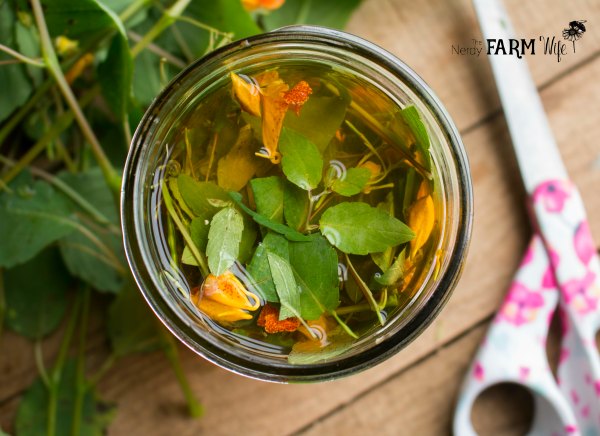
6. Jewelweed
Jewelweed (Impatiens capensis) is a pretty annual wildflower that’s best known for treating poison ivy or poison oak. It’s also great for other itchy or inflamed skin conditions, such as bug bites!
The good stuff in jewelweed is mainly found in the stems and leaves, but the flowers can be used too. Fresh is best when it comes to jewelweed – dried jewelweed doesn’t do much.
You can use it to make frozen jewelweed juice cubes using the directions above in #5.
Jewelweed can also be infused in vinegar (see #2 above) or included in soaps.
Check out my article: Preserving and Using Jewelweed (6 Uses) for directions to make either a cold process soap, or an easy melt and pour soap with jewelweed.

7. Aloe + Fresh Herbs for Bug Bites
Aloe gel is super soothing when applied to red, itchy, and inflamed conditions. Here, we’re blending together equal parts of fresh plant – such as plantain leaves, violet leaves, violet flowers, calendula flowers, or rose petals – to make an herbal infused aloe. Refrigerate the gel for a day or two, or strain and freeze in ice trays for longer storage.
More information can be found in these articles:
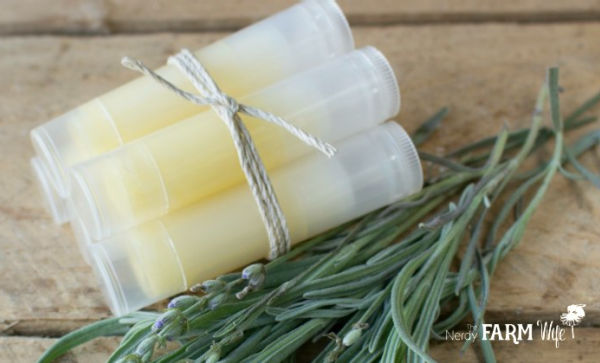
8. Bug Bite Itchy Sticks
These easy DIY bug bite sticks relieve the itchiness of pesky bug bites and are perfect for outdoor enthusiasts on the go! They’re kid friendly too – older kids can apply their own bug bite relief as needed.
Find the full recipe in my article:

9. Oatmeal and/or Milk Bath
Make a skin soothing bath by combining oats (we use gluten free rolled oats), and/or milk powder (cow or goat), and/or dried herbs such as calendula, plantain, violet, chamomile, chickweed, and yarrow.
Tie the mixture up into a sock (so you don’t get gritty floaty bits in your tub) and throw it in your bath! Use about 1 cup per bath.
Here’s the recipe for the soak shown, which makes enough for two baths, but feel free to adjust ingredients to suit your personal preferences.
Itchy Skin Oatmeal Milk Bath
- 1 cup rolled oats
- 1/2 cup milk powder
- 1/4 cup dried chamomile, crumbled
- 1/4 cup dried plantain (or chickweed), crumbled
- 1/4 cup dried calendula flowers, crumbled
Mix everything together and store in jars. Use about 1 heaping cup per bath. Be sure not to put directly in your bath water or you’ll be picking little bits of oats and herbs off of your skin. Instead, tie it up in a little muslin bath bag, or a sock, to keep your tub clean.
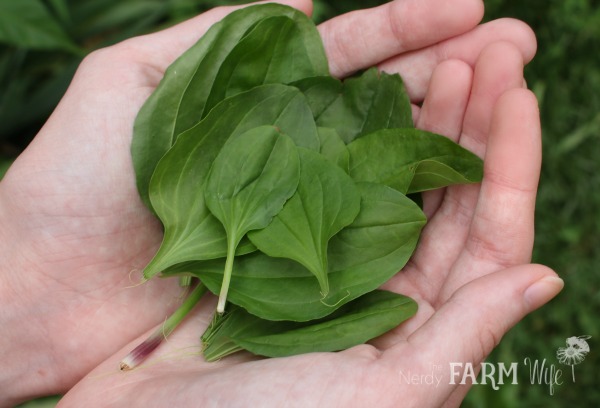
10. Spit Poultice for Bug Bites
So, I know this sounds gross, but if you’re outside with no first aid kit handy – a spit poultice is amazingly helpful for bug bites and bee stings, as well as scrapes, splinters, and other minor skin irritations!
Basically, all you need to do is find a beneficial leaf or flower – such as plantain, yarrow, violet, rose petals – chew it up a bit, then spit it out and place on the affected area for a while or until it starts to feel better. You can hold it in place with your fingers, a strip of cloth, or even a sock if needed.

11. Black Drawing Salve
I make this charcoal and clay drawing salve to help with the splinters we get from stacking and handling firewood a lot, but it’s also excellent for bug bites, especially spider bites.
If you get bit by a spider, first identify it and make sure you don’t need emergency medical attention. (For example, if it were a black widow or brown recluse spider bite, I’d seek medical advice.) For less toxic spiders, we pull out the drawing salve, put a dab directly on the bite, then cover with a bandage. Charcoal black salve is also helpful for bee stings, bug bites, and boils.
Drawing Salve Recipe {with charcoal & clay}
More things to make for itchy skin in general:
Simple Calendula Salve (#2 on this list)


In Florida, we NEED a strong, quick fix for bug bites! I found that chewing a leaf of holy basil (tulsi) and applying directly to the bite provides instant relief. It helps with mosquitos and sand gnats. It removes the red swelling and lasting itch if left on bite for 10 minutes. Easy to grow and I use it for tea normally but have it planted all over the garden and flower beds so the kids can apply and keep playing, all by themselves. They have been taught what to use!
Hi Mary, That’s such a great idea and so helpful to know! Thank you for sharing!
The rose petal hand balm in your book(pg 59) has been our go to for mosquito bites. I don’t know why it works but it is a miracle cure
Hi Paul, That’s wonderful to hear & good to know! Thanks for sharing!
Thanks for all your tips!!! I tried my first lotions this spring with your recipes. The Purple Dead Nettle in Hemp Oil has been amazing for me and my friends and it is one of the 3 or 4 lotions and salves I will continue to make. It almost instantly stopped poison ivy pain and itching on a friend and me and bug bites on a friend. Adding the hemp was more effective than just a PDN lotion. Thanks much!!!!
Hi Beckie, That’s so wonderful to hear that the hemp and purple dead nettle lotion helped so much!! ❤